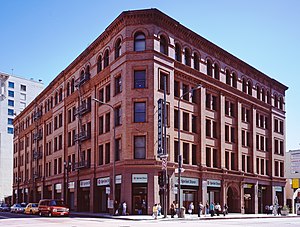Bradbury Building
|
Bradbury Building
|
|

(2005)
|
|
| Location | 304 South Broadway Los Angeles, California |
|---|---|
| Coordinates | 34°3′1.93″N 118°14′52.30″W / 34.0505361°N 118.2478611°WCoordinates: 34°3′1.93″N 118°14′52.30″W / 34.0505361°N 118.2478611°W |
| Built | 1892 - 1893 or 1894 |
| Architect | Sumner Hunt, George Wyman |
| Architectural style | Italian Renaissance Revival, Romanesque Revival, Chicago School |
| NRHP Reference # | 71000144 |
| LAHCM # | 6 |
| Significant dates | |
| Added to NRHP | July 14, 1971 |
| Designated NHL | May 5, 1977 |
| Designated LAHCM | September 21, 1962 |
The Bradbury Building is an architectural landmark located at 304 South Broadway at West 3rd Street in downtown Los Angeles, California. Built in 1893, the five-story office building is best known for its extraordinary skylit atrium of access walkways, stairs and elevators, and their ornate ironwork. The building was commissioned by Los Angeles gold-mining millionaire Lewis L. Bradbury and constructed by draftsman George Wyman from the original design by Sumner Hunt. It appears in many works of fiction and has been the site of many movie and television shoots and music videos.
The building was added to the National Register of Historic Places in 1971, and was designated a National Historic Landmark in 1977, one of only four office buildings in Los Angeles to be so honored. It was also designated a landmark by the Los Angeles Cultural Heritage Commission and is the city's oldest landmarked building.
Lewis L. Bradbury (November 6, 1823 – July 15, 1892) was a gold-mining millionaire – he owned the Tajo mine in Sinaloa, Mexico – who became a real estate developer in the later part of his life. In 1892 he began planning to construct a five-story building at Broadway and Third Street in Los Angeles, close to the Bunker Hill neighborhood. A local architect, Sumner Hunt, was hired to design the building, and turned in a completed design, but Bradbury dismissed Hunt's plans as inadequate to the grand building he wanted. He then hired George Wyman, one of Hunt's draftsmen, to do the design. Bradbury supposedly felt that Wyman understood his own vision of the building better than Hunt did, but there is no concrete evidence that Wyman changed Hunt's design, which has raised some controversy about who should be considered to be the architect of the building. Wyman had no formal education as an architect, and was working for Hunt for $5 a week at the time.
...
Wikipedia



